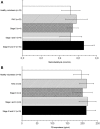Plasma Lipidomic Signature of Rectal Adenocarcinoma Reveals Potential Biomarkers
- PMID: 29359123
- PMCID: PMC5766651
- DOI: 10.3389/fonc.2017.00325
Plasma Lipidomic Signature of Rectal Adenocarcinoma Reveals Potential Biomarkers
Abstract
Background: Rectal adenocarcinoma (RAC) is a common malignant tumor of the digestive tract and survival is highly dependent upon stage of disease at diagnosis. Lipidomic strategy can be used to identify potential biomarkers for establishing early diagnosis or therapeutic programs for RAC.
Objective: To evaluate the lipoperoxidation biomarkers and lipidomic signature in the plasma of patients with RAC (n = 23) and healthy controls (n = 18).
Methods: Lipoperoxidation was evaluated based on malondialdehyde (MDA) and F2-isoprostane levels and the lipidomic profile obtained by gas chromatography and high resolution mass spectrometry (ESI-q-TOF) associated with a multivariate statistical technique.
Results: The most abundant ions identified in the RAC patients were those of protonated phosphatidylcholine and phosphatidylethanolamine. It was found that a lisophosphatidylcholine (LPC) plasmalogen containing palmitoleic acid [LPC (P-16:1)], with highest variable importance projection score, showed a tendency to be lower in the cancer patients. A reduction of n - 3 polyunsaturated fatty acids was observed in the plasma of these patients. MDA levels were higher in patients with advanced cancer (stages III/IV) than in the early stages groups and the healthy group (p < 0.05). No differences in F2-isoprostane levels were observed among these groups.
Conclusion: This study shows that the reduction in plasma levels of LPC plasmalogens associated with an increase in MDA levels may indicate increased oxidative stress in these patients and identify the metabolite LPC (P-16:1) as a putatively novel lipid signature for RAC.
Keywords: biomarkers; lipidomic; lipoperoxidation; mass spectrometry; rectal adenocarcinoma.
Figures




References
-
- Schmidt MI, Duncan BB, Silva GA, Menezes AM, Monteiro CA, Barreto SM, et al. Doenças crônicas não transmissíveis no Brasil: carga e desafios atuais. Séries Lancet (2011) 377(9781):61–74.10.1016/S0140-6736(11)60135-9 - DOI
-
- INCA: Instituto Nacional do Câncer. Estimativa 2016: incidência de câncer no Brasil. Rio de Janeiro: Ministério da Saúde; (2015). 122 p.
LinkOut - more resources
Full Text Sources
Other Literature Sources
Miscellaneous

